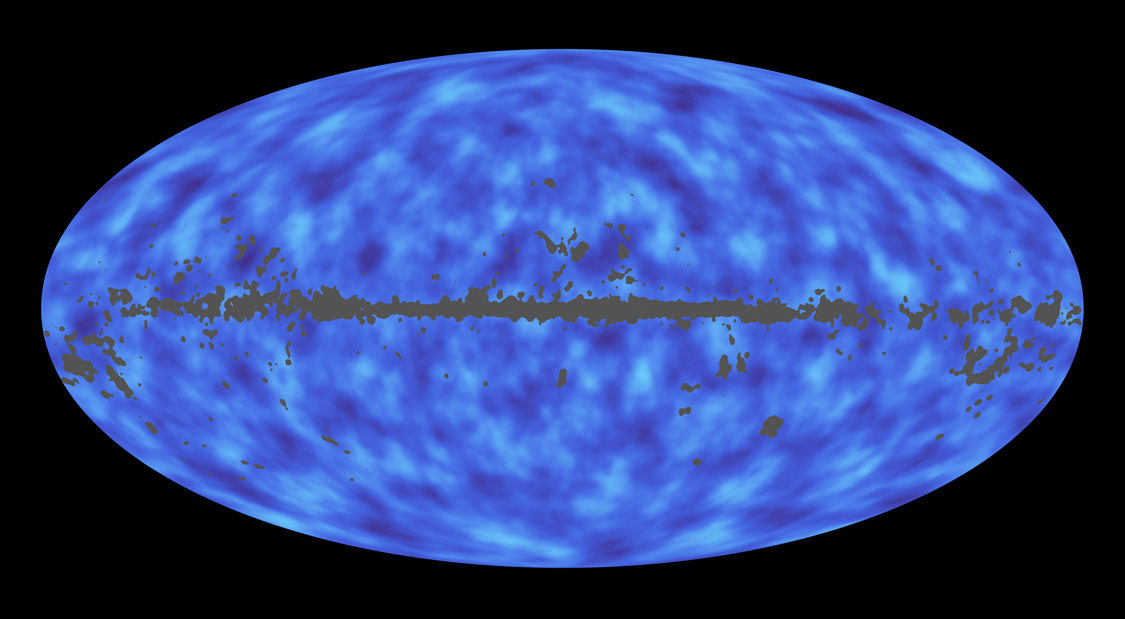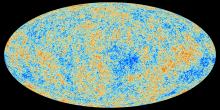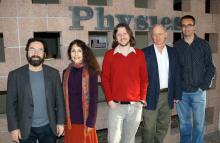
Planck Mission Brings Universe Into Sharp Focus


The Planck space mission today has released the most accurate and detailed map ever made of the oldest light in the universe, revealing new information about its age, contents, and origins. Planck is a European Space Agency mission with significant NASA participation.
Five UC Santa Barbara scientists are part of the Planck team. The group will hold a free public talk to discuss the new data –– and their implications –– starting at 3 p.m. today, March 21, at the California NanoSystems Institute, in Elings Hall, Room 1601.
"The Planck data now give us one of the most profound views of our origins, complete with imperfections," said Philip Lubin, a professor of physics at UCSB and Planck mission co-investigator. "The UCSB Planck group has been working nearly two decades on this mission, collaborating with hundreds of scientists, engineers, and educators around the world to complete this milestone in our vision of the early universe."
The results suggest the universe is expanding more slowly than scientists thought, and is 13.8 billion years old, 100 million years older than previous estimates. The data also show there is less dark energy and more matter, both normal and dark matter, in the universe than previously known. Dark matter is an invisible substance that only can be seen through the effects of its gravity, while dark energy is pushing our universe apart. The nature of both remains mysterious.
"Astronomers worldwide have been on the edge of their seats waiting for this map," said Joan Centrella, Planck program scientist at NASA Headquarters in Washington. "These measurements are profoundly important to many areas of science, as well as future space missions. We are so pleased to have worked with the European Space Agency on such a historic endeavor."
The map, based on the mission's first 15.5 months of all-sky observations, reveals tiny temperature fluctuations in the cosmic microwave background, ancient light that has traveled for billions of years from the very early universe to reach us. The patterns of light represent the seeds of galaxies and clusters of galaxies we see around us today.
"In addition to providing new insights into the origin and structure of the universe, Planck's data also contain the most detailed maps of our own galaxy which have provided new insights into the interstellar medium –– the material which fills the Milky Way between its 100 billion stars," said Gregory Dobler, astrophysicist, Planck team member, and postdoctoral fellow at the Kavli Institute for Theoretical Physics.
The age, contents, and other fundamental traits of our universe are described in a simple model developed by scientists, called the standard model of cosmology. These new data have allowed scientists to test and improve the accuracy of this model with the greatest precision yet. At the same time, some curious features are observed that don't quite fit with the simple picture. For example, the model assumes the sky is the same everywhere, but the light patterns are asymmetrical on two halves of the sky, and there is a cold spot extending over a patch of sky that is larger than expected.
"Planck is the most complex and sensitive space mission ever launched to measure the earliest light in the universe, and it has worked flawlessly, returning incredible images of the sky that have enabled the most precise analysis yet of the fundamental properties of our universe," said Peter Meinhold, a research physicist at UCSB and Planck core team scientist. "These data are a treasure trove of cosmological and astrophysical information. They confirm our core model of cosmology, while the extreme precision and internal consistency of the results may be starting to illuminate ways in which our understanding is incomplete."
The findings also test theories describing inflation, a dramatic expansion of the universe that occurred immediately after its birth. In far less time than it takes to blink an eye, the universe blew up by 100 trillion trillion times in size. The new map, by showing that matter seems to be distributed randomly, suggests that random processes were at play in the very early universe on minute "quantum" scales. This allows scientists to rule out many complex inflation theories in favor of simple ones.
"While the Planck data are relatively consistent with the ideas of inflation, dark energy, and dark matter, we still lack a detailed understanding of just what those things are, and whether the inflationary period we suppose did indeed happen," Lubin said. "Perhaps the most curious aspects of the data are the anomalies we have seen. Their origins are unclear. Whether they indicate some change in our fundamental understanding remains to be explored."
Planck launched in 2009 and has been scanning the skies ever since, mapping the cosmic microwave background, the afterglow of the big bang that created our universe. This relic radiation provides scientists with a snapshot of the universe 370,000 years after the big bang. Light existed before this time, but it was locked in a hot plasma similar to a candle flame, which later cooled and set the light free.
The cosmic microwave background is remarkably uniform over the entire sky, but tiny variations reveal the imprints of sound waves triggered by quantum fluctuations in the universe just moments after it was born. These imprints, appearing as splotches in the Planck map, are the seeds from which matter grew, forming stars and galaxies. Prior balloon-based and space missions learned a great deal by studying these patterns, including NASA's Wilkinson Microwave Anisotropy Probe (WMAP) and the Cosmic Background Explorer (COBE), which earned the 2006 Nobel Prize in Physics.
Planck is the successor to these satellites, covering a wider range of light frequencies with improved sensitivity and resolution. Its measurements reveal light patterns as small as one-twelfth of a degree on the sky.
"Planck provides the first consistent view of the cosmic microwave background from large to tiny scales, without the need to create a patchwork of results from several experiments," said Andrea Zonca, a Planck core team scientist and postdoctoral fellow in the physics department. "The UCSB team has been working in close collaboration with the Low Frequency Instrument data center in Trieste, Italy, to understand and characterize the data from raw detectors output to sky maps."
The newly estimated expansion rate of the universe, known as Hubble's constant, is 67.15 plus or minus 1.2 kilometers/second/megaparsec. A megaparsec is roughly 3 million light-years. This is less than prior estimates derived from space telescopes, such as NASA's Spitzer and Hubble, using a different technique. The new estimate of dark matter content in the universe is 26.8 percent, up from 24 percent, while dark energy falls to 68.3 percent, down from 71.4 percent. Normal matter now is 4.9 percent, up from 4.6 percent.
"The Planck education group has been developing interactive simulations, utilizing innovative media techniques –– including immersive virtual reality and sonification –– to support the presentation of Planck's exciting cosmology results to students and the public," said Jatila van der Veen, Planck project manager for education and public outreach, a research associate in UCSB's physics department, and a lecturer in the College of Creative Studies.
The simulations can be viewed online at http://www.deepspace.ucsb.edu/projects/planck. An interactive installation is now on display at the Santa Barbara Museum of Natural History's Gladwin Planetarium.
Complete results from Planck, which still is scanning the skies, will be released in 2014.
NASA's Planck Project Office is based at JPL. JPL contributed mission-enabling technology for both of Planck's science instruments. European, Canadian and U.S. Planck scientists work together to analyze the Planck data.
For more information about Planck, visit http://www.nasa.gov/planck.
† Top image: Map of Matter in the Universe: This full-sky map from the Planck mission shows matter between Earth and the edge of the observable universe. Regions with less mass show up as lighter areas while regions with more mass are darker. The grayed-out areas are where light from our own galaxy was too bright, blocking Planck's ability to map the more distant matter. Normal matter, which is made up of atoms, is only a small percent of the total mass in our universe. Most of the matter in the universe is dark — that is, it does not emit or absorb any light —so creating a map of its distribution is challenging. To make the full-sky map, the Planck team took advantage of the fact that all matter, even dark matter, has gravity that will affect light traveling to us from near the very edge of the observable universe. Planck mapped this light, called the cosmic microwave background, with exquisite precision over the whole sky, enabling scientists to create this matter map.
Credit: ESA/NASA/JPL-Caltech
†† Middle image: Best Map Ever of the Universe: This map shows the oldest light in our universe, as detected with the greatest precision yet by the Planck mission. The ancient light, called the cosmic microwave background, was imprinted on the sky when the universe was 370,000 years old. It shows tiny temperature fluctuations that correspond to regions of slightly different densities, representing the seeds of all future structure: the stars and galaxies of today. By analyzing the light patterns in this map, scientists are fine tuning what we know about the universe, including its origins, fate and basic components.
Credit: ESA and the Planck Collaboration
††† Bottom image: UCSB's Planck team includes, from left, Philip Lubin, professor of physics and Planck co-investigator; Jatila van der Veen, project manager for education and public outreach, and a research associate in physics; Gregory Dobler, astrophysicist and postdoctoral fellow at the Kavli Institute for Theoretical Physics; Peter Meinhold, research physicist and core team scientist; and Andrea Zonca, core team scientist and postdoctoral fellow in the physics department.
Credit: George Foulsham



